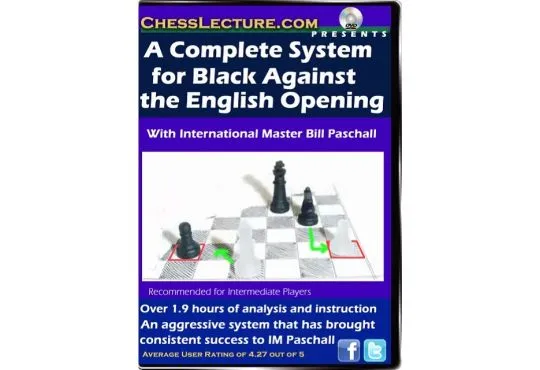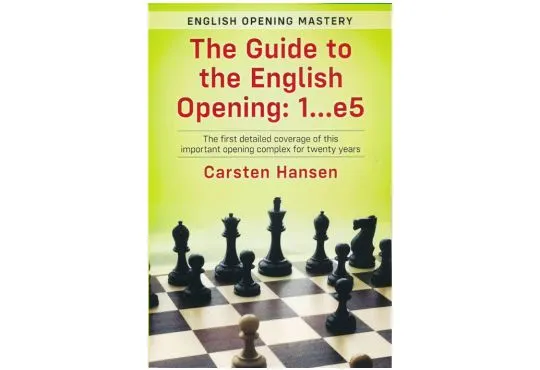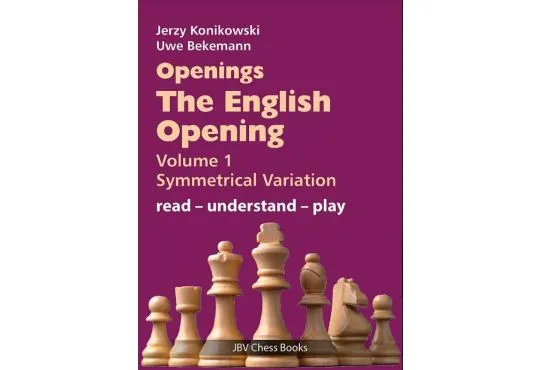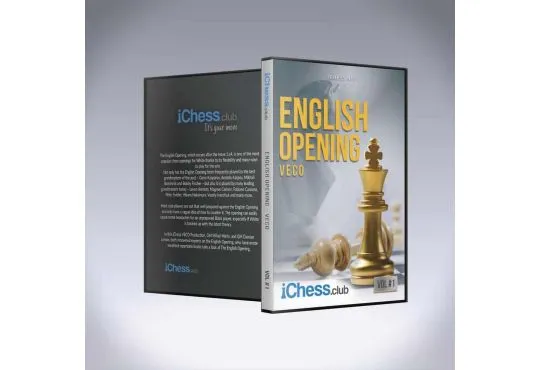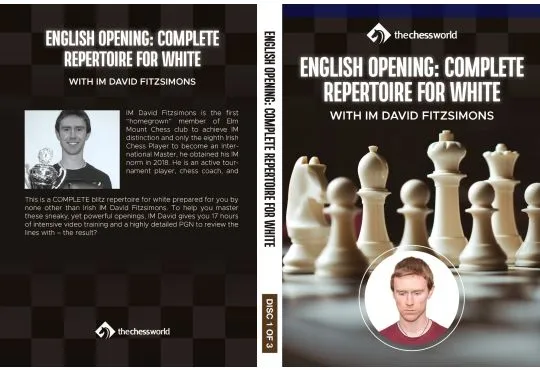The English Opening: A Powerhouse For White
The first move in a game of chess sets the tone for the battle to follow. The King’s Pawn Opening often results in sharp, dynamic games. Offbeat choices such as the Grob Opening can throw your opponent off balance, and can lead to a wildly chaotic struggle. And then there is the English Opening - the subject of today’s article - which usually indicates that a drawn-out strategic game is afoot.
Your choice of opening should be a reflection of your strengths as a chess player and the sorts of positions you enjoy.
If you like to gradually outmaneuver your opponent, the English Opening is a great way to start the game with White.
This article will cover:
- The origins of the English Opening.
- Different setups the English Opening can lead to.
- How to further your education in this interesting flank opening.
The English Opening - Introduction and Origins
The English Opening begins with 1. c4.
The most notable first user of the English Opening was, as you might imagine, an Englishman. Howard Staunton was a seminal figure in chess during the mid-19th century. At one point, Staunton was widely regarded as the strongest chess player in the world. He also helped to organize the first ever international chess tournament, held in London in 1851.
Another of Staunton’s contributions relates to the shape of the chess pieces that have become the international standard for tournament play to this very day. Staunton endorsed and promoted the design, and as a result they became known as the “Staunton” chessmen.
Related: Check out the American Staunton chess set, box and board combination - available from the USCF store.
Staunton played 1. c4 in several important games, including in his 1843 match against the French player Pierre Charles Fournier de Saint-Amant, where Staunton began with 1. c4 six times with the White pieces. At the time, this was a very unusual way to start the game. Staunton emerged victorious in the match with 11 wins, 4 draws, and 6 losses, and 1. c4 came to be known as the “English Opening” in a nod to Staunton’s influence.
Why Play The English Opening?
Today, the English Opening is the 4th-most common first move at master level.
Source: chess.com’s opening explorer
The move 1. c4 achieves several useful objectives for White:
- It helps to control the important d5 square.
- It allows White to develop their queenside knight to c3 with the c-pawn in front of (rather than behind) the knight.
- It opens the a4-d1 diagonal, giving the White queen a potential avenue to develop.
The English Opening is considered to be a flexible opening choice for White. It tends to mostly lead to positional middlegames. Both players tend to develop their pieces normally and get their kings safe. Critical moments and tactics do not usually occur early in the game.
The English Opening is often considered to be a close relative of the Réti Opening, (1. Nf3 d5 2. c4). Throughout the early stages in both openings, there are a wide range of reasonable moves that both players can play. This means that less rote memorization is necessary. Ideas and plans are more important than your ability to recite move-by-move sequences.
Different Setups In The English Opening
Given that the “English Opening” occurs on move one, there are many ways that Black can play against it. Each of these have their own body of opening theory and thematic ideas - so for the purposes of this article we shall simply show the most important setups and provide some brief commentary that can help inform the reader’s further study.
1. … e5: The King’s English
Black’s most popular way of meeting the King’s Pawn Opening (1. e4) is 1. …c5 - the Sicilian Defense. When Black plays 1. …e5 against the English Opening, the position closely resembles a Sicilian, but with White (cast in the role of the “Sicilian” player) enjoying an extra tempo compared to what Black has in the Sicilian proper.
The ideas for White here are similar to what Black attempts to do in the Sicilian. In general, White should look to play on the queenside. A kingside fianchetto (g3 and Bg2) to support this plan can be one idea. b4 to claim additional queenside space can be another.
1. …c5: The Symmetrical English
As is the case with the Symmetrical King’s Pawn Opening (1. e4 e5) and the Symmetrical Queen’s Pawn Opening (1. d4 d5), it is also possible for Black to simply copy White’s first move. Playing 1. …c5 makes the immediate 2. d4 less attractive for White, meaning that this pawn break will need to be prepared first.
From here, White has a variety of setups at their disposal, including the c4-d3-e4 Botvinnik pawn structure.
Related: Enhance your understanding of important pawn structures with Pawn Structures You Should Know by Adrian Mikhalchishin, available from the USCF store.
1. …Nf6: The Anglo-Indian
By playing 1. …Nf6, Black is yet to declare their intentions - instead, Black has answered White’s flexible first move with a flexible first move of their own.
Black could go for a King’s Indian Defense setup. A Nimzo-Indian could also be on the cards. Black could also play e5 if Black does not prevent it by playing d4.
Again, in most cases Black’s play tends to be on the queenside with a kingside fianchetto.
Getting Started With The English Opening
Beyond this article, what else can you do to prepare yourself to play the English Opening?
As mentioned earlier, there are many replies that Black can play against the English Opening. It would be useful to dive right in and play some online blitz chess to see them for yourself. Take note of which variations Black most commonly plays. This information will help inform which variations deserve more attention in your further study.
Next, we recommend watching this short video from GM Simon Williams, which introduces some more ideas in the English Opening.
If you like what you see, the same instructor has a comprehensive video training course: The English Opening - available from the USCF store.
This course includes:
- Almost 6 hours of recorded video lessons.
- Interactive training including video feedback.
- An analysis file which includes 50 model games.
For those who prefer learning with books, we strongly recommend The Full English Opening by Carsten Hansen.
This single volume by the acclaimed chess opening expert covers all the variations you need to know to play the English Opening like a master. It can be your one-stop guide to develop a repertoire you can be fully confident in with the White pieces.
Related: Tips to improve your chess opening study.
Summary: Is The English Opening Right For You?
The English Opening could be worth consideration if you:
- Prefer ideas and plans to memorized openings. In the English Opening, you will need to think for yourself from early in the game. Reciting opening moves from memory is not as important. This means you will need to spend less of your valuable time studying opening lines - time which you can use to improve other areas of your game.
- Enjoy the ability to transpose into different setups. Due to its inherent flexibility, a strong English Opening player should always be on the lookout for subtle move order nuances to gain small advantages if their opponent isn’t paying attention.
- Prefer a positional game. The English Opening is often quite slow and strategic. While tactics are always possible, it is generally the case that positional understanding is more vital than having a sharp tactical eye in middlegames stemming from the English Opening.
If that sounds like the kind of chess opening for White you would enjoy, then begin your journey with the English Opening today!
Frequently Asked Questions
The English Opening is a chess opening for White starting with the move 1. c4. It helps White fight for the center by controlling the important d5 square, prepares to play Nc3 while having the c-pawn in front of the knight, and opens the a4-d8 diagonal for the White queen.
Yes, the English Opening is a very good opening choice for White. It is White’s 4th-most played first move (behind only 1. e4, 1. d4 and 1. Nf3). The English Opening has a reputation of being more flexible, and requiring less opening memorization than 1. e4.
The English Opening was named after Howard Staunton, one of the leading English players from the mid-19th century. Staunton began with 1. c4 six times when playing with the White pieces in his 1843 match against the Frenchman Pierre Charles Fournier de Saint-Amant in Paris. Staunton also played 1. c4 at the important London 1851 international chess tournament.
The best way to learn the English Opening is through studying resources such as books or videos, combined with practical experience. The best book available on the English Opening is The Full English Opening by Carsten Hansen. This one-volume guide has everything you need to master this versatile opening for White.


